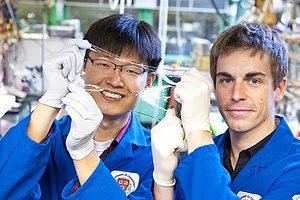In a breakthrough moment, researchers at Harvard School of Engineering and Applied Sciences have developed a novel material resembling a simple transparent disk, which the researchers applied an electrical signal to and used it to play music. This is no ordinary speaker, though. The disk consists of a thin sheet of rubber sandwiched between two layers of a saltwater gel, and represents the first demonstration that electrical charges carried by ions, rather than electrons, can be put to meaningful use in fast-moving, high-voltage devices.
Using ionic materials for high voltage applications has been thought to be intractable in the past, due to the high number of constraints. High voltages can set off electrochemical reactions in ionic materials, producing gases and burning up the materials. Also, ions, being much larger than electrons, take longer to propagate through a circuit affecting signal quality. The system developed at Harvard overcomes both of these challenges, all while exposing a number of benefits inaccessible to traditional, electron carrying conductors.
“Ionic conductors could replace certain electronic systems; they even offer several advantages,” says co-lead author Jeong-Yun Sun, a postdoctoral fellow at the Harvard School of Engineering and Applied Sciences(SEAS).

And, we’re not talking here just about sound speakers. The researchers chose to design a speaker with their compound material simply because its the best proof of concept. To produce sound in the whole human audible spectrum – 20 Hz to 20kHz – a speaker needs to carry high voltage and be capable of contracting rapidly to produce vibrations and push the air in a specific manner, producing what we commonly refer to as sound. This wasn’t though possible in the past for ionic conductors.
“It must seem counterintuitive to many people, that ionic conductors could be used in a system that requires very fast actuation, like our speaker,” said Sun. “Yet by exploiting the rubber layer as an insulator, we’re able to control the voltage at the interfaces where the gel connects to the electrodes, so we don’t have to worry about unwanted chemical reactions. The input signal is an alternating current, and we use the rubber sheet as a capacitor, which blocks the flow of charge carriers through the circuit. As a result, we don’t have to continuously move the ions in one direction, which would be slow; we simply redistribute them, which we can do thousands of times per second.”
Ions that play music
Since it can suit the high demands a speaker poses, the material is versatile enough to be used in other applications, where other options aren’t available. Key traits of the Harvard ionic conductor include: the capacity to stretch to many times their normal area without an increase in resistivity (common issue in stretchy electronics); transparency (high reward of optics apps); bio-compatibility (!).
A video demonstration of the gel-based audio speaker can be seen in the video embedded below.
Immediate applications includes devices that need a soft, transparent layer that deforms in response to electrical stimuli — for example, on the screen of a TV, laptop, or smartphone to generate sound or provide localized haptic feedback. Smart windows are also a highly interesting and appealing idea – you could potentially place this speaker on a window and achieve active noise cancellation, with complete silence inside.
“With wearable computing devices becoming a reality, you could imagine eventually having a pair of glasses that toggles between wide-angle, telephoto, or reading modes based on voice commands or gestures,” suggested Sam Liss, director of business development in Harvard’s Office of Technology Development
The term capabilities of the technology are far more interesting, however. The electrical signal that relays information to and fro the brain is actually carried by charged ions, not electrons. Seeing how the ionic conductor developed at Harvard is also biocompatible, it’s not difficult to imagine high-tech biotechnology like artificial muscles, limbs or organs meshing in this novel material.
“The big vision is soft machines,” said co-lead author Christoph Keplinger, who worked on the project as a postdoctoral fellow at SEAS and in the Department of Chemistry and Chemical Biology. “Engineered ionic systems can achieve a lot of functions that our body has: They can sense, they can conduct a signal, and they can actuate movement. We’re really approaching the type of soft machine that biology has to offer.”
The ion conductor was described in a paper published in the journal Science.


